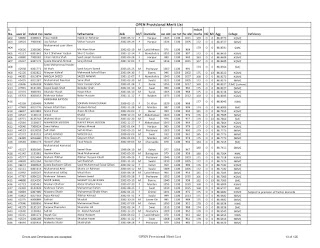Chap. Measurments Tips and Tricks
→ The standard
of Weight and Measures Act was passed in India in
1976. It recommended the use of SI in all
fields of science, technology,
trade and industry.
→ The
dimensions of many physical quantities, especially those in
heat, thermodynamics, electricity and
magnetism in terms of mass,
length and time alone become irrational.
Therefore, SI is adopted which
uses 7 basic units.
Bank
Of MCQs Bank Of MCQs Bank Of MCQs
→ The
dimensions of a physical quantity are the powers to which
→ The
dimensional formula is very helpful in writing the unit of a
physical quantity in terms of the basic
units.
→ The
dimensions of a physical quantity do not depend on the system
of units.
→ A physical
quantity that does not have any unit must be
dimensionless.
→ The pure
numbers are dimensionless.
→ Generally,
the symbols of those basic units, whose dimension
(power) in the dimensional formula is zero,
are omitted from the
dimensional formula.
Bank
Of MCQs Bank Of MCQs Bank Of MCQs
→ It is wrong
to say that the dimensions of force are MLT–2. On the
other hand we should say that the
dimensional formula for force is MLT–2
and that the dimensions of force are 1 in
mass, 1 in length and –2 in
time.
→ Physical
quantities defined as the ratio of two similar quantities are
dimensionless.
→ The physical
relation involving logarithm, exponential,
trigonometric ratios, numerical factors
etc. cannot be derived by the
method of dimensional analysis.
Bank
Of MCQs Bank Of MCQs Bank Of MCQs
→ Physical
relations involving addition or subtraction sign cannot be
derived by the method of dimensional analysis.
→ If units or
dimensions of two physical quantities are same, these
need not represent the same physical
characteristics. For example torque
and work have the same units and dimensions
but their physical
characteristics are different.
→ The standard
units must not change with space and time. That is
why atomic standard of length and time have
been defined. Attempts are
being made to define the atomic standard
for mass as well.
→ The unit of
time, the second, was initially defined in terms of the
rotation of the earth around the sun as
well as that about its own axis.
This time standard is subjected to
variation with time. Therefore, the
atomic standard of time has been defined.
Bank
Of MCQs Bank Of MCQs Bank Of MCQs
→ Any
repetitive phenomenon, such as an oscillating pendulum,
spinning of earth about its axis, etc can
be used to measure time.
→ The product
of numerical value of the physical quantity (n) and its
unit (U) remains constant..
→ The product
of numerical value (n) and unit (U) of a physical
quantity is called magnitude of the
physical quantity.
Thus : Magnitude = nU
→ Poiseuille
(unit of viscosity) = pascal (unit of pressure) × second.
That is : Pl : Pa- s.
→ The unit of
power of lens (dioptre) gives the ability of the lens to
converge or diverge the rays refracted
through it.
Bank
Of MCQs Bank Of MCQs Bank Of MCQs
→ The order
of magnitude of a quantity means its value (in suitable
power of 10) nearest to the actual value of
the quantity.
→ Angle is
exceptional physical quantity, which though is a ratio of
two similar physical quantities (angle =
arc / radius) but still requires a
unit (degrees or radians) to specify it
along with its numerical value.
→ Solid angle
subtended at a point inside the closed surface is 4
steradian.
A measurement of a physical quantity is
said to be accurate if the
systematic error in its measurement is
relatively very low. On the other
hand, the measurement of a physical
quantity is said to be precise if the
random error is small.
→ A
measurement is most accurate if its observed value is very close
to the true value.
→ Errors are
always additive in nature.
→ For greater
accuracy, the quantity with higher power should have
least error.
→ The
absolute error in each measurement is equal to the least count
of the measuring instrument.
→ Percentage
error = relative error × 100.
→ The unit
and dimensions of the absolute error are same as that of
quantity itself.
Bank
Of MCQs Bank Of MCQs Bank Of MCQs
→ Absolute
error is not dimensionless quantity.
→ Relative
error is dimensionless quantity.
→ Smaller the
least count, higher is the accuracy of measurement.
→ Larger the
number of significant figures after the decimal in a
measurement, higher is the accuracy of
measurement.
→ Significant
figures do not change if we measure a physical quantity
in different units.
→ Significant
figures retained after mathematical operation (like
addition, subtraction, multiplication and
division) should be equal to the
minimum significant figures involved in any
physical quantity in the
given operation.
→ Significant
figures are the number of digits upto which we are sure
about their accuracy.
Bank
Of MCQs Bank Of MCQs Bank Of MCQs
→ If a number
is without a decimal and ends in one or more zeros,
then all the zeros at the end of the number
may not be significant.
→ 1 inch = 2.54
cm
1 foot = 12 inches = 30.48 cm = 0.3048 m
1 mile = 5280 ft = 1.609 km
→ 1 yard = 0.9144
m
1 slug = 14.59 kg
→ 1 barn = 10–28
m2
Bank
Of MCQs Bank Of MCQs Bank Of MCQs
→ 1 liter = 103
cm3 = 10–3 m3
→ 1 g/cm3 = 1000
kg/m3
→ 1 atm. = 76
cm of Hg = 1.013 × 105 N/m2
1 N/m2 = Pa (Pascal)
→ When we add
or subtract two measured quantities, the absolute
error in the final result is equal to the
sum of the absolute errors in the
measured quantities.
→ When we
multiply or divide two measured quantities, the relative
error in the final result is equal to the
sum of the relative errors in the
measured quantities
Bank
Of MCQs Bank Of MCQs Bank Of MCQs









Comments
Post a Comment